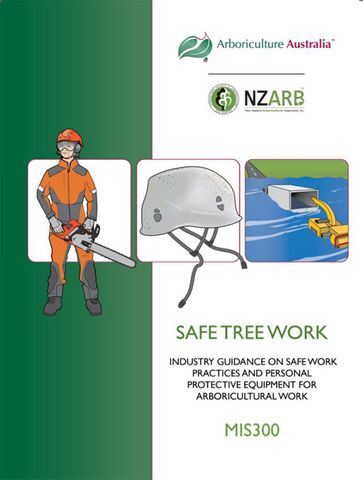
MIS300 Safe Tree Work
MIS301 Arborist Knots - 2nd ed.
Minimum Industry Standard series Members Price is for Members of The New Zealand Arboricultural Association (NZARB). The vision of NZ Arb is to represent the arboriculture community and make it the primary organisation for tree care and to maintain relevancy to the Association’s members, so if you are in the NZ tree care industry please consider joining NZARB by clicking the link above if you are not already a member. |
This book is one in a series of Minimum Industry Standards produced by Arboriculture Australia Ltd and the New Zealand Arboricultural Association in consultation with the national arboriculture community in both countries. These industry peer-reviewed documents provide a ‘body of knowledge’ which is shared by practitioners and can be used as the basis for training, dissemination of skills and professional development.
This document covers the core work skills of operating safely on tree work sites. The document is aimed at workers conducting tree pruning and removal operations, rather than consultancy, testing or other types of arboricultural works.
Contents:
1: Working in arboriculture
Introduction
Fundamentals of safe work in arboriculture
- Safe work framework
Risk management
- Risk management process
- Sample risk matrix
- Risk control measures
- Example risk control measures
- Competency for the task
- Safety responsibilities at work
Fit for work
- Diet
2: Preparing to conduct tree work
Receiving work instructions
- Permits and notifications
- Selecting and preparing equipment and PPE:
Personal Protective Equipment (PPE) for Arboriculture
- PPE Frequently Asked Questions
- A minimum standard for PPE
- Helmet
- Eye protection
- Hearing protection
- Safety boots
- Chainsaw protective clothing
- High visibility clothing
- Sun protection
- Gloves
- Arc flash protection
- Other PPE
Working in remote areas
3: Arriving on site
- Approval to be on site
- Deciding on a work plan
Site and tree risk assessment
- Safe Work Method Statements and risk controls
- Recording site and tree inspection
- Completing the JSA or similar
Site hazards
- Uneven or disturbed ground
- Insects or wildlife
- Hangers
- Allergenic plants or vines
- Electrical conductors and other services
- Weather conditions
Tree hazards
Environmental impact and control measures
- Environmental management plan
- Waste/clean-up management plan
- Water quality protection
- Noise control
- Dust/debris management
Site setup and preparations for work
- Preparing the site
- Work site exclusion zones
- Signs
- Traffic management
- Emergency preparations
- Aerial rescue
- Pre-start checks
4: Conducting tree work
Safe work practices: accident prevention methods
- Examples of safe work practices
- Basic site safety rules
- Work methods
- Manual handling
- Heat stress and dehydration
- Fatigue and stress
- Stress management
Communication during tree work
- Call-and-response protocol
- Methods of communication on tree sites
- Hand and whistle signals for use on tree sites
- Site management during tree work
5: Completing tree works
- Processing debris
- Cleaning, storing and transporting equipment
- Retiring condemned equipment
- Completion of works
Minimum Industry Standards
The Minimum Industry Standard series is dedicated to all our fellow workers who have lost their lives or have been permanently injured working in the arboriculture and vegetation management industries.
The Minimum Industry Standards project is an Arboriculture Australia led initiative that the NZ Arb is pleased and proud to be involved with. Having joined the programme, NZ Arb works alongside Arboriculture Australia to develop these Minimum Industry Standards. Each Minimum Industry Standard (MIS) provides the key knowledge that is necessary to perform the work task.
| Dimensions | 150 x 210 mm |
| Pages | 129 |
| Cover | Soft Cover |
| Binding | Wire-O |
